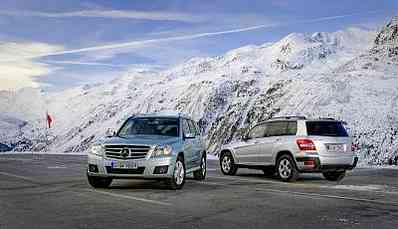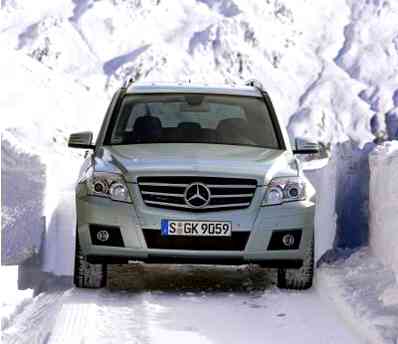
The
Stuttgart-based brand
2008

2008
ZUR DEUTSCHEN
VERSION |
The permanent all-wheel-drive system 4MATIC
The 4MATIC drive
system in the GLK is among the most powerful all-wheel-drive systems there
is; its control systems break new ground. Advantages over other systems with
a transversely installed drive unit are achieved thanks to the basic compact,
light and friction-loss-optimised design with its longitudinally positioned
engine and integrated main and transfer case.
 Fuel consumption, for example, is at the same level
as that of a comparable, conventionally driven vehicle, whilst noise and
vibration levels are on a par with those in higher vehicle categories. In
cooperation with the dynamic handling control systems ESP®, acceleration
skid control ASR and 4ETS, the basic 45:55 percent torque split between the
front and rear axle ensures assured and predictable handling. When fine-tuning
the control systems the engineers at the Mercedes-Benz Technology Centre
placed particular importance on defined understeer characteristics, as displayed
by all GLK models even in the most varied of road conditions: on dry roads,
in rain, snow, ice or on unsurfaced roads. A double-disc clutch achieving
a basic locking torque of approximately 50 Nm between the front and rear
axle is fitted to the central differential. The clutch pack is permanently
preloaded via a plate spring. In the case of spinning wheels on one of the
two axles, a friction torque is transmitted to the axle spinning more slowly
by relative movement of the discs. A sustained improvement to traction and
directional stability of the vehicle are achieved through this principle
of variable torque shift. Particularly in the case of low coefficients of
friction between the tyres and the road surface the traction and stabilising
effect of this so-called pre-lock clutch is clearly noticeable. Fuel consumption, for example, is at the same level
as that of a comparable, conventionally driven vehicle, whilst noise and
vibration levels are on a par with those in higher vehicle categories. In
cooperation with the dynamic handling control systems ESP®, acceleration
skid control ASR and 4ETS, the basic 45:55 percent torque split between the
front and rear axle ensures assured and predictable handling. When fine-tuning
the control systems the engineers at the Mercedes-Benz Technology Centre
placed particular importance on defined understeer characteristics, as displayed
by all GLK models even in the most varied of road conditions: on dry roads,
in rain, snow, ice or on unsurfaced roads. A double-disc clutch achieving
a basic locking torque of approximately 50 Nm between the front and rear
axle is fitted to the central differential. The clutch pack is permanently
preloaded via a plate spring. In the case of spinning wheels on one of the
two axles, a friction torque is transmitted to the axle spinning more slowly
by relative movement of the discs. A sustained improvement to traction and
directional stability of the vehicle are achieved through this principle
of variable torque shift. Particularly in the case of low coefficients of
friction between the tyres and the road surface the traction and stabilising
effect of this so-called pre-lock clutch is clearly noticeable. |
Adaptive Brake: state-of-the-art brake control
system enables shortest stopping distances - even in wintry road
conditions
 The newly developed ADAPTIVE BRAKE control system
encompasses the following basic functions: the anti-lock braking system ABS,
acceleration skid control ASR and yaw moment control. ABS and ASR record
and control the driving situation longitudinally, the yaw moment control
the lateral dynamics. If ADAPTIVE BRAKE diagnoses critical operating conditions,
within the limits of the laws of physics traction and directional stability
are retained or reinstated through precise brake actuation and drive torque
control. New additional functions make ADAPTIVE BRAKE even safer and more
convenient. Hill Start Assist prevents the vehicle from rolling unintentionally
in the opposite direction of travel wished by the driver. A function known
as priming has also been added. If the driver quickly removes his or her
foot from the accelerator, the system prepares for possible panic braking
by placing the brake linings on the brake discs using little pressure. Through
the indirect pressure build-up when operating the brake pedal this will then
shorten the stopping distance if a full brake application does occur. Thanks
to ADAPTIVE BRAKE's ability to produce even the slightest amounts of brake
pressure precisely, it is possible to remove the film of water which forms
on the brake discs in wet conditions through brief, light brake actuation.
This reduces even further the brake response time, and thus the stopping
distance, in the wet. Intervention takes place as soon as the windscreen
wiper has reached a certain number of wipe cycles and the driver has not
braked of his or her own accord in the meantime. The GLK is fitted with adaptive
brake lights as standard. This system warns following traffic that there
is a critical braking situation by initiating flashing of the brake lights
if the vehicle's rate of deceleration is high. In the case of emergency braking
from a speed of over 70 km/h the hazard warning lights are automatically
activated when the vehicle comes to standstill. The "off-road" switch in
the centre console helps the GLK-Class to make good progress on rough terrain
if the equipment line with the "off-road engineering package" is selected.
At the touch of a button a special drive program comes into operation; it
varies the 7G-TRONIC's shift points, "softens" the accelerator characteristic
and activates the ESP® functions with off-road ABS and a special off-road
4ETS. A further switch turns on the DSR (Downhill Speed Regulation) which
automatically keeps to a pre-selected speed between 4 and 18 km/h on steep
downhill inclines. The driver can vary the speed at any time using the cruise
control lever. In addition to a tyre pressure loss warning system the GLK's
Electronic Stability Program ESP® comprises vehicle/trailer stabilisation
as standard. This diffuses critical operating conditions through precise
brake actuation as they arise. The maximum towing capacity is 2000 kilograms. The newly developed ADAPTIVE BRAKE control system
encompasses the following basic functions: the anti-lock braking system ABS,
acceleration skid control ASR and yaw moment control. ABS and ASR record
and control the driving situation longitudinally, the yaw moment control
the lateral dynamics. If ADAPTIVE BRAKE diagnoses critical operating conditions,
within the limits of the laws of physics traction and directional stability
are retained or reinstated through precise brake actuation and drive torque
control. New additional functions make ADAPTIVE BRAKE even safer and more
convenient. Hill Start Assist prevents the vehicle from rolling unintentionally
in the opposite direction of travel wished by the driver. A function known
as priming has also been added. If the driver quickly removes his or her
foot from the accelerator, the system prepares for possible panic braking
by placing the brake linings on the brake discs using little pressure. Through
the indirect pressure build-up when operating the brake pedal this will then
shorten the stopping distance if a full brake application does occur. Thanks
to ADAPTIVE BRAKE's ability to produce even the slightest amounts of brake
pressure precisely, it is possible to remove the film of water which forms
on the brake discs in wet conditions through brief, light brake actuation.
This reduces even further the brake response time, and thus the stopping
distance, in the wet. Intervention takes place as soon as the windscreen
wiper has reached a certain number of wipe cycles and the driver has not
braked of his or her own accord in the meantime. The GLK is fitted with adaptive
brake lights as standard. This system warns following traffic that there
is a critical braking situation by initiating flashing of the brake lights
if the vehicle's rate of deceleration is high. In the case of emergency braking
from a speed of over 70 km/h the hazard warning lights are automatically
activated when the vehicle comes to standstill. The "off-road" switch in
the centre console helps the GLK-Class to make good progress on rough terrain
if the equipment line with the "off-road engineering package" is selected.
At the touch of a button a special drive program comes into operation; it
varies the 7G-TRONIC's shift points, "softens" the accelerator characteristic
and activates the ESP® functions with off-road ABS and a special off-road
4ETS. A further switch turns on the DSR (Downhill Speed Regulation) which
automatically keeps to a pre-selected speed between 4 and 18 km/h on steep
downhill inclines. The driver can vary the speed at any time using the cruise
control lever. In addition to a tyre pressure loss warning system the GLK's
Electronic Stability Program ESP® comprises vehicle/trailer stabilisation
as standard. This diffuses critical operating conditions through precise
brake actuation as they arise. The maximum towing capacity is 2000 kilograms. |
READER COMMENTS
Daimler Communications, 70546
Stuttgart, Germany
Mercedes-Benz – a brand of Daimler AG, December 08, 2008 |
BACK TO TOP |
